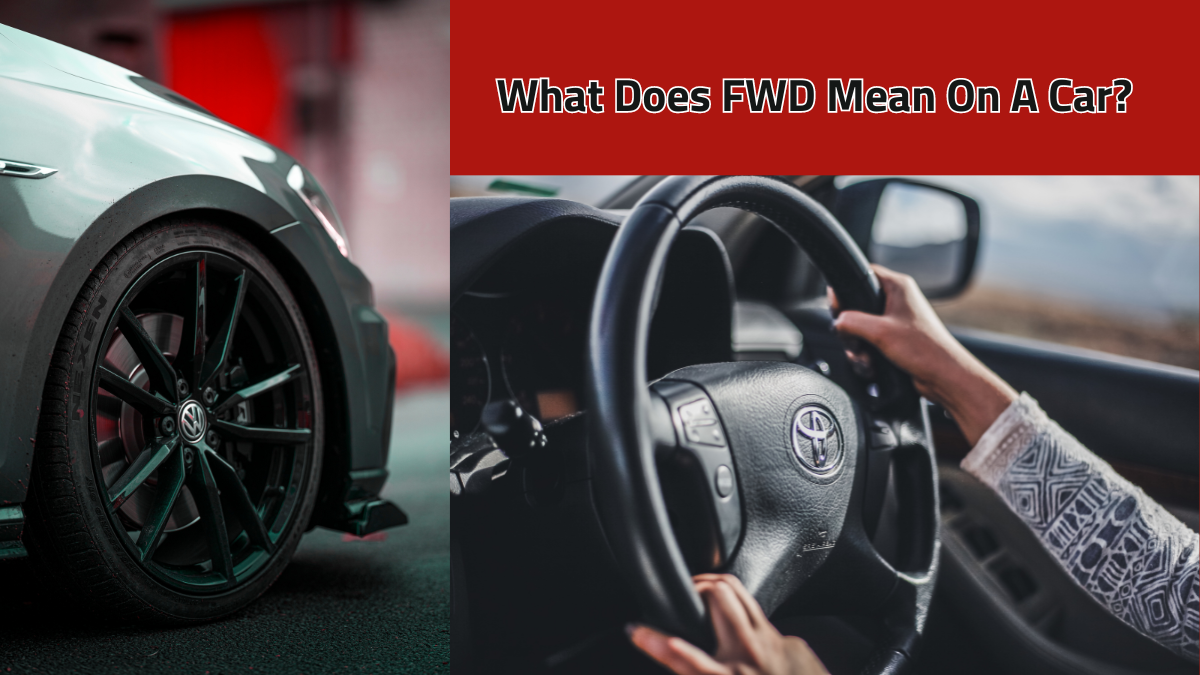What Does FWD Mean on a Car
What is FWD?
Table of Contents
ToggleHave you ever wondered what FWD stands for when you’re checking out car specs? FWD, or Front-Wheel Drive, is a common term you’ll come across in the automotive world. But what exactly does it mean, and why should you care? Let’s dive in and break it down.
Understand FWD (Front-Wheel Drive)
How FWD Works
So, how does FWD actually work? It’s pretty simple, really. In a Front-Wheel Drive system, the engine’s power is directed to the front wheels. This means that the front wheels are responsible for both steering and propelling the car forward. The main components involved are the transaxle, front differential, and CV (constant velocity) joints, which all work together to deliver power smoothly to the front wheels.
Advantages of FWD
Why do so many cars use FWD? There are several advantages to this setup:
- Improved Fuel Efficiency: Since FWD systems are generally lighter than other drivetrains, they tend to offer better fuel economy.
- Better Traction in Certain Conditions: FWD cars can handle better in slippery conditions, like rain or snow, because the weight of the engine is over the drive wheels.
- Cost-Effectiveness in Production: FWD systems are cheaper to manufacture, which often translates to a lower purchase price for consumers.
FWD vs. Other Drivetrains
FWD vs. RWD (Rear-Wheel Drive)
When it comes to FWD vs. RWD, there are some key differences to consider:
- Performance: RWD cars are often favored for their superior handling and balance, especially in high-performance vehicles. However, FWD cars tend to be more stable and easier to handle for everyday driving.
- Traction: FWD vehicles generally perform better in poor weather conditions due to the weight distribution, whereas RWD cars might struggle.
FWD vs. AWD (All-Wheel Drive)
How does FWD stack up against AWD?
- Traction and Control: AWD systems provide power to all four wheels, offering better traction and control in various driving conditions. This makes AWD ideal for off-road or severe weather driving.
- Cost and Complexity: AWD systems are more complex and expensive to maintain. FWD, on the other hand, is simpler and cheaper.
FWD vs. 4WD (Four-Wheel Drive)
And what about FWD vs. 4WD?
- Off-Road Capability: 4WD systems are designed for serious off-road adventures, providing power to all four wheels and handling rough terrain with ease. FWD is not meant for off-roading.
- Usage: FWD is more suitable for everyday driving, offering simplicity and efficiency, while 4WD is for those who need extra power and capability.
FWD Performance in Various Conditions
FWD in Snow and Ice
Driving a FWD car in snow and ice can be a mixed bag. On one hand, the weight over the front wheels provides better traction, helping you get through slippery conditions. On the other hand, you might find it challenging to control under heavy snow.
- Handling and Safety Tips: Keep your speed low, use gentle acceleration, and avoid sudden movements to maintain control.
- Pros and Cons: FWD cars offer decent performance in mild winter conditions, but they might struggle in deeper snow or on icy roads.
FWD in Rain
Rainy weather can also pose a challenge for drivers, but FWD cars generally handle well.
- Handling and Safety Tips: Ensure your tires are in good condition and avoid driving through deep puddles.
- Pros and Cons: FWD provides good traction on wet roads, but aquaplaning can still occur if you’re not careful.
FWD in Dry Conditions
In dry conditions, FWD cars perform efficiently and reliably.
- Handling and Safety Tips: Regular maintenance and proper tire inflation are key to ensuring optimal performance.
- Pros and Cons: FWD cars are stable and easy to handle on dry roads, offering a smooth driving experience.
Common Misconceptions about FWD
FWD and Handling
There’s a myth that FWD cars handle poorly compared to other drivetrains. While it’s true that RWD and AWD can offer better handling in some scenarios, modern FWD cars are designed to provide a balanced and stable driving experience.
- Real-World Performance Insights: Many FWD cars are equipped with advanced traction control systems that enhance their handling capabilities.
FWD and Speed
Another common misconception is that FWD cars are slower. While they might not match the performance of high-end sports cars, FWD vehicles can still offer plenty of speed and acceleration for everyday driving.
- Real-World Performance Insights: Many FWD cars are quick off the line and provide a spirited driving experience.
Maintaining a FWD Vehicle
Regular Maintenance Tips
To keep your FWD car running smoothly, regular maintenance is essential.
- Essential Maintenance Tasks: This includes regular oil changes, tire rotations, brake inspections, and checking fluid levels.
- Tips for Prolonging Vehicle Life: Follow the manufacturer’s maintenance schedule and address any issues promptly to avoid bigger problems down the road.
Troubleshooting Common Issues
Even with regular maintenance, FWD vehicles can encounter problems. Here are some common issues and their solutions:
- Unusual Noises: If you hear grinding or clicking sounds, it could indicate problems with the CV joints or the transaxle. It’s best to have these checked by a professional.
- Vibrations: Excessive vibrations while driving might be due to unbalanced tires, worn-out suspension components, or issues with the drivetrain.
- Poor Handling: If your FWD car is handling poorly, check the tire pressure, alignment, and suspension components.
The Future of FWD
Technological Advancements
FWD technology continues to evolve with advancements aimed at improving performance, efficiency, and safety.
- Innovations in FWD Technology: Modern FWD cars often feature advanced traction control systems, electronic stability control, and more efficient transaxles.
- Future Trends and Predictions: As technology progresses, we can expect even better fuel efficiency, enhanced driving dynamics, and more integration with electric and hybrid systems.
Market Trends
FWD remains a popular choice among consumers, but the market is always shifting.
- Popularity of FWD in Modern Vehicles: Many manufacturers continue to produce FWD cars due to their cost-effectiveness and efficiency.
- Consumer Preferences and Market Shifts: While there’s a growing interest in AWD and electric vehicles, FWD still holds a significant market share, especially in the compact and mid-size car segments.
Conclusion
Now you know What Does FWD Mean On A Car. In summary, understanding what FWD means and how it works can help you make informed decisions when choosing your next car. FWD offers several advantages, including improved fuel efficiency, better traction in certain conditions, and cost-effectiveness. While there are some misconceptions about its performance, modern FWD cars are designed to provide a balanced and stable driving experience. Regular maintenance and troubleshooting common issues can help you keep your FWD vehicle running smoothly. With ongoing advancements and shifting market trends, the future of FWD looks promising.
FAQs
Which is better, FWD or AWD?
It depends on your needs. AWD offers better traction and control in various conditions, but FWD is simpler, more fuel-efficient, and cheaper to maintain.
Are FWD cars good in snow?
FWD cars can handle well in mild snow conditions due to the weight over the front wheels, but they might struggle in heavy snow or ice.
Is it better to have FWD or RWD?
FWD is generally better for everyday driving and offers better traction in wet or snowy conditions, while RWD is favored for performance and handling.
Does FWD mean 4×4?
No, FWD means Front-Wheel Drive, where only the front wheels are powered. 4×4, or Four-Wheel Drive, means all four wheels receive power.
What are the disadvantages of FWD cars?
Some disadvantages include potential understeer in sharp turns, reduced handling in high-performance scenarios, and difficulty in off-road conditions.
Is AWD really worth it?
AWD can be worth it if you frequently drive in challenging conditions like snow, rain, or off-road. It offers better traction and control but comes at a higher cost.
Is FWD good in rain?
Yes, FWD provides good traction in rainy conditions, helping to maintain stability and control on wet roads.
How to drive FWD?
Drive FWD cars just like any other vehicle, but be mindful of acceleration and turning, especially in slippery conditions to avoid understeer.
How to safely drive FWD in snow?
Maintain a slow and steady pace, avoid sudden movements, and use gentle acceleration to prevent loss of traction.
What are the benefits of FWD?
Benefits include improved fuel efficiency, better traction in certain conditions, lower production costs, and more interior space due to the compact drivetrain layout.
Why do people prefer RWD?
RWD is often preferred for its superior handling, balance, and performance, especially in sports and luxury vehicles.
Why are most cars FWD?
Most cars are FWD because it’s cost-effective, efficient, and provides adequate performance for everyday driving.
Is FWD bad for handling?
Not necessarily. Modern FWD cars are designed to offer good handling and stability, although they might not match the performance of RWD or AWD in some scenarios.
Why are FWD cars slower?
FWD cars might be slower compared to high-performance RWD or AWD cars due to weight distribution and drivetrain limitations, but they are generally adequate for everyday driving.
Can you drift with FWD?
Drifting with FWD is challenging but possible with techniques like the handbrake turn. However, it’s not as effective or easy as drifting with RWD.
What is the disadvantage of FWD?
The main disadvantages include potential understeer in sharp turns, reduced handling in high-performance scenarios, and difficulty in off-road conditions.
What shouldn’t you do on a FWD car?
Avoid aggressive acceleration or sudden turns in slippery conditions to prevent understeer. Also, avoid off-roading as FWD is not designed for it.
Can you hydroplane in a FWD?
Yes, FWD cars can hydroplane if driving too fast in wet conditions. Proper tire maintenance and cautious driving can help prevent this.
How bad is FWD in the snow?
FWD can handle mild snow well but might struggle in deeper snow or ice. Using winter tires and driving cautiously can improve performance.
Does FWD use more gas?
No, FWD is generally more fuel-efficient than RWD or AWD due to its lighter weight and simpler design.
What is the problem with front-wheel drive cars?
Common problems include potential understeer, reduced handling in high-performance scenarios, and challenges in off-road conditions.
Are FWD cars worth it?
Yes, FWD cars are worth it for most drivers due to their fuel efficiency, cost-effectiveness, and adequate performance for everyday driving.
Why are all Hondas FWD?
Many Hondas are FWD because it offers a good balance of efficiency, performance, and cost-effectiveness, making it suitable for a wide range of drivers.
Can FWD cars spin out?
FWD cars can spin out, especially in slippery conditions or if driven aggressively. Proper driving techniques and good tire maintenance can help prevent this.
Do you need to rotate tires on FWD?
Yes, regular tire rotation is important for FWD cars to ensure even tire wear and maintain optimal handling and performance.
Why did cars switch to FWD?
Cars switched to FWD for improved fuel efficiency, better space utilization, and cost-effective production.
Can FWD cars fishtail?
FWD cars are less likely to fishtail compared to RWD cars, but it can still happen in certain conditions, such as heavy braking on slippery surface.
This was the whole detailed article on What Does FWD Mean On A Car.
I hope it helped.
Learn more:
FWD vs AWD | Which One To Choose? (Full Comparison)
FWD vs AWD: Which is the Right Choice for You? Which One To Choose AWD or FWD ? Choosing the appropriate drivetrain for your vehicle is critical to achieving peak performance, safety, and efficiency. The most prevalent drivetrain options are … Read more
Best AWD Sedans | Top Sedans In Every Segment
Best AWD Sedans All-Wheel Drive (AWD) sedans have become increasingly popular due to their enhanced traction, stability, and performance in various driving conditions. Whether you’re navigating through snowy terrains or seeking better handling on wet roads, an AWD sedan can … Read more


